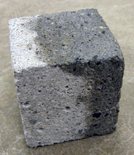Keeping concrete watertight is a challenge. As a porous material, concrete can allow water to migrate through, corroding steel reinforcement, bringing in harmful chemicals and creating general livability issues. This is why most construction industry professionals use some sort of waterproofing product to protect their concrete structures. So how do you know if your waterproofing product actually works?
There are two methods commonly used to determine if concrete is waterproof: absorption and permeability testing.

Absorption test showing how much water was absorbed into the concrete block.
Absorption tests are useful for concrete under non-hydrostatic conditions, such as above ground concrete that primarily needs protection from rain. They are applicable to hydrophobic products, which are designed to repel water from the concrete surface.
Permeability tests require specialized equipment and cannot be done by all testing agencies. Products that are required to resist water under pressure must be evaluated using this testing method.

Permeability test showing the depth of water penetration.
Described in detail in BS EN 12390-8 and DIN 1048-5, water under constant high pressure is applied to one face of a concrete sample for a period of 72 hours. When the test is completed, the specimens are split open and the depth of water penetration is measured. This test method is useful for structures such as basements, tunnels and water reservoirs because it recreates the pressure conditions that these structures are subjected to in a realistic way. Remember that these test methods are comparative. No matter which method you use, be sure to test the waterproofing agent against an identical plain concrete sample, using the same proportions of cement, aggregates and water.
The most effective way to test an integral system’s ability to resist water penetration is through a permeability test. These tests take into account how integral systems actually work. They allow you to determine how deeply the water has penetrated and whether crystal growth has started to occur.


